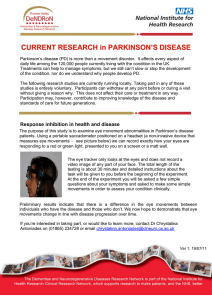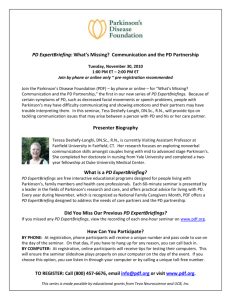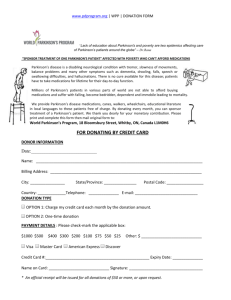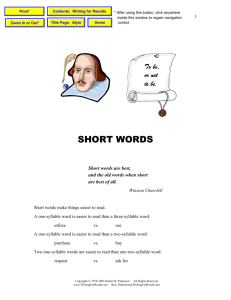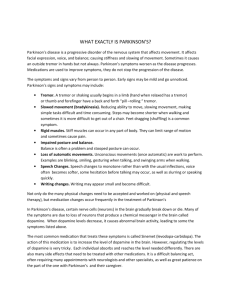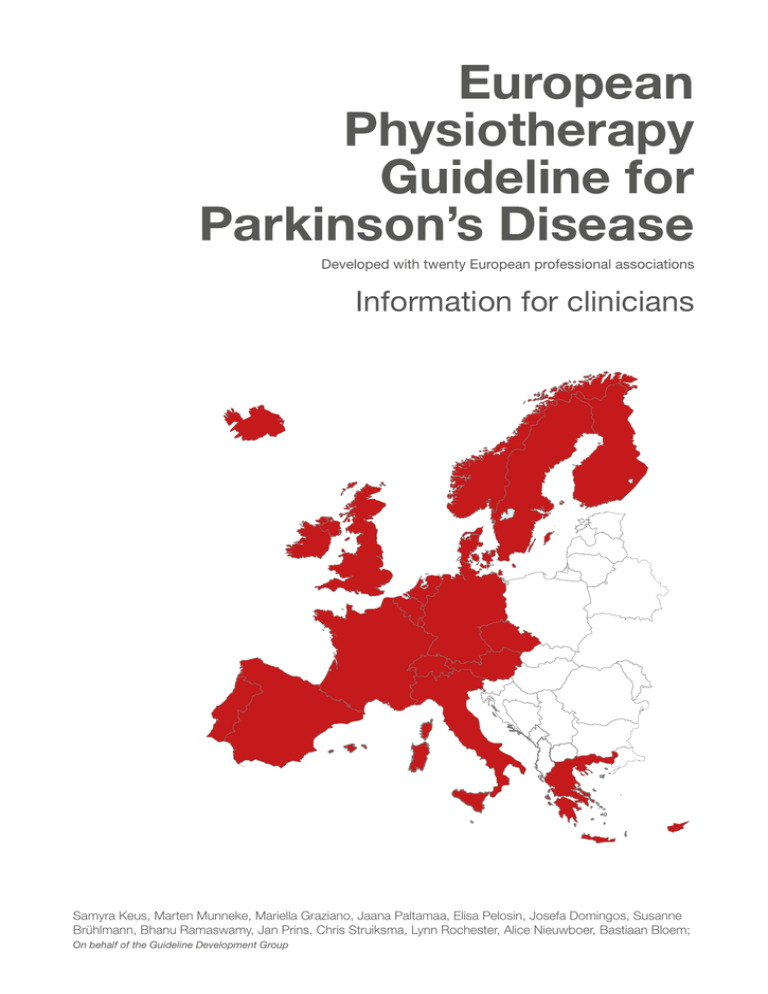
European
Physiotherapy
Guideline for
Parkinson’s Disease
Developed with twenty European professional associations
Information for clinicians
Samyra Keus, Marten Munneke, Mariella Graziano, Jaana Paltamaa, Elisa Pelosin, Josefa Domingos, Susanne
Brühlmann, Bhanu Ramaswamy, Jan Prins, Chris Struiksma, Lynn Rochester, Alice Nieuwboer, Bastiaan Bloem;
On behalf of the Guideline Development Group
European Physiotherapy Guideline for Parkinson’s disease
The development of this guideline was initiated and mainly
This Guideline is endorsed by the Association for
financed by ParkinsonNet and the Royal Dutch Society for
Physiotherapists in Parkinson’s Disease Europe (APPDE),
Physical Therapy (KNGF), the Netherlands
the European Parkinson’s Disease Association (EPDA) and
the European Region of the World Confederation for Physical
Therapy (ER-WCPT).
Available for downloading at www.parkinsonnet.info/euguideline are
- Guideline
- Guideline information for people with Parkinson's
Reference to this publication
Keus SHJ, Munneke M, Graziano M, et al. European Physiotherapy
Guideline for Parkinson’s disease. 2014; KNGF/ParkinsonNet, the
Netherlands
- Guideline information for clinicians (this document)
- Development and scientific justification
Copyright © 2014 KNGF/ParkinsonNet
All rights reserved. No part of this publication may be reproduced,
1st edition, December 2014
transmitted or stored in a retrieval system of any nature, in any form or
by any means, without prior permission in writing of the copyright owner.
A link to a pdf of this publication is available on www.parkinsonnet.info/
Design by Puntkomma
2
euguideline. This link may be used without prior permission.
© ParkinsonNet | KNGF 2014
The European Physiotherapy Guideline for Parkinson's disease supports physiotherapists in taking decisions towards
patient-centred, evidence-informed practice. It also offers people with Parkinson's disease (pwp) information and tools to
manage their movement-related health to focus on goals that are important to them. Here we provide a short overview of
the Guideline for clinicians to support optimal referral of pwp to physiotherapy, feasible expectations and good communication.
A joint collaboration of 19 European countries
ParkinsonNet, a non profit foundation at the Radboudumc university medical centre aiming to improve Parkinson's care,
and the Royal Dutch Society for Physical Therapy (KNGF) initiated the development of this first European Physiotherapy
Guideline for Parkinson’s disease. The Guideline Development Group (GDG) represents professional physiotherapy associations
from 19 European countries. Pwp were involved in the Guideline development from the outset and have contributed
throughout the process. The Guideline is endorsed by the Association for Physiotherapists in Parkinson’s Disease Europe
(APPDE), the European Parkinson’s Disease Association (EPDA) and the European Region of the World Confederation for
Physical Therapy (ER-WCPT).
Methods of development: GRADE
The starting point for this Guideline were the 2004 evidence-based KNGF Guideline for Parkinson’s disease1 and a panEuropean physiotherapy survey to gain insight in current physiotherapy care and barriers and facilitators towards optimal
care. To draft recommendations, Grades of Recommendation Assessment, Development and Evaluation (GRADE) were
used. Therefore, the levels and description of the recommendations differ from those reported in the Guidelines published
by the KNGF, the European Federation of Neurological Societies (EFNS), the Movement Disorders Society (MDS) and the
U.K. National Institute for Health and Clinical Excellence (NICE)2-6. GRADE is endosed by many organisations and journals,
including the Cochrane Collaboration, the World Health Organization, NICE and the British Medical Journal. Using GRADE,
recommendations are based on:
•
Critical outcomes: those with a mean GDG-rated score for importance of 6.5 or above (full scale 1 to 10)
•
Quality of the evidence: taking into account risk of bias (such as regarding randomisation, blinding, drop-outs) and
imprecision (such as few patients included)
•
Size of the effects: a meta-analyses was carried out
•
Benefits and burdens: taking into account the generalisability of the effects, undesirable effects of the intervention
and values and preferences of patients and therapists
Literature up and to December 2012 was searched for, selected and appraised. Finally, 70 controlled clinical trials were
used7-76.
This Guideline provides GRADE-based recommendations for each physiotherapy core area: balance, gait, transfers and
physical capacity. Based on the outcome of the meta-analyses, recommendations are either for or against using a specific
type of physiotherapy intervention to target a specific problem. The strength of this recommendation can be strong or
weak, based on the quality of the evidence and the balance between benefits and burden. The risk and burden of
physiotherapy is generally very low. Please note that ‘against’ means that benefits probably do not outweigh risks and
burdens. Most commonly, effects showed a positive trend, but the (wide) confidence interval of the effect included 0.
‘Against’ does not mean that the specific intervention has negative effects on that outcome.
3
European Physiotherapy Guideline for Parkinson’s disease
In addition to the GRADE-based recommendations, the Guideline provides GDG advice which is based on scientific
evidence and expert opinion. These aim to reduce the barriers inhibiting optimal physiotherapy care identified through the
pan-European physiotherapy survey (response n=3,405)77;78, meetings with Parkinson-expert physiotherapists and results
of focus groups with pwp. They concern the physiotherapist's Parkinson-specific knowledge and skills, timely referral,
patient-centeredness, collaboration and communication.
When and why to refer for physiotherapy?
The American Academy of Neurology recommends clinicians discuss the potential of physiotherapy with pwp at least
annually.79 To support appropriate referral, the GDG has drafted criteria for referral (Table 1). These are in line with the
GRADE-based recommendations for interventions. Referral may be based on one or more of the following criteria: H&Y
Stage; presenting impairments and activity limitations; hospital or nursing home admission.
Table 1 Referral criteria for pwp to physiotherapy
Based on*
Description
Stage: Early
Soon after the diagnosis of Parkinson’s disease for:
• self-management advice, education and coaching, including support to stay
physical active
• if required, tailored intervention to prevent limitations in functional mobility
through motor learning, to reduce fear of falling and to improve physical
capacity
Presence of:
• Reduced physical capacity
• Functional mobility limitations regarding:
--transfers, such as rising from a chair or rolling over in bed
--gait, including freezing
--balance, including falls
--manual activities
• Pain, non-related to medication
If admitted to a hospital for any cause, or to a nursing home, aiming to educate
and, if necessary, train pwp and health professionals to improve physical
capacity or limitations in functional mobility, or to support prevention of falls
(e.g. using walking aids) and pressure sores
Specific impairments or
limitations in activities
Context: hospital or nursing
home
*In addition, specifically trained physiotherapists in the United Kingdom, have a qualification in non-medical prescribing. They have the ability to prescribe,
as well as supply and administer medicines to individually named patients.80 The terms by which this process occurs are legislated and monitored under
strict guidance
Stage-based: early referral
Early referral is desired because difficulties in daily activities can be present even in the early stages of Parkinson’s disease.
At Hoehn & Yahr 1-2, the total scores on the Unified Parkinson’s Disease Rating Scale (UPDRS) may already be below
20.81;82 This is particularly the case in pwp with the PIGD-type.83 Physiotherapy can improve activity limitations.
Early referral is also important to support pwp to maintain sufficient physical activity levels and thus prevent secondary
complications. Exercise has multiple physiological, psychological and physical benefits and may even result in neurprotection84.
During a one-off consultation, a physiotherapist can evaluate the needs for advice and education, coaching towards selfmanagement or supervised training. On www.parkinsonnet.info/euguideline, Information for people with Parkinson's can
be downloaded, supporting pwp in their self-management.
4
© ParkinsonNet | KNGF 2014
Problem-based: impairments and activity limitations
During the course of the condition, the number of impairments in functions, activity limitations and restrictions in participation
will increase. There is consistent data supporting physiotherapy referral and use in Parkinson’s disease for transfers and
mobility problems, gait disturbances, balance, falls and freezing.
Context-based: hospital or nursing home admission
The lack of Parkinson-expertise of health professionals may enhance the risk for adverse events during hospital and nursing
home stay86-91. Problem areas include adverse events related to medication (e.g. wrong timing, withdrawal, or use of contraindicated drugs), swallowing and immobilisation, including falls and pressure sores86-94. Therefore, the GDG recommends
to consult a physiotherapist when pwp are admitted to hospital.87 Physiotherapy will provide education and, if required,
exercise to support prevention of falls, pressure sores and a decrease of physical capacity. Next to pwp, physiotherapy
targets health professionals involved in hospital care, such as nurses.
To which physiotherapist to refer?
Parkinson’s disease is complex and evidence on physiotherapy-specific interventions for pwp is constantly increasing.
Moreover, in some European countries physiotherapists are first-contact practitioners not requiring a medical referral.
Therefore, it is critical that physiotherapists are fully-informed regarding the evidence95. Whilst there is no golden standard
for ‘Parkinson’s-expertise’, this phenomenon is associated with the number of pwp treated annually. Physiotherapists with
a annual treatment volume of seven report higher self-perceived expertise than those treating less than four pwp annually.96
However, results of a survey in which 3,405 physiotherapists throughout Europe participated showed that on average most
physiotherapists treat as few as four pwp annually. This treatment volume is unlikely to be sufficient to gain and maintain
Parkinson’s-expertise. The median needed treatment number to gain and retain sufficient expertise reported was 10, with
50% of the answers ranging from 6 to 20. Often, this number will be hard to reach. Most physiotherapists reported limited
Parkinson’s-expertise; had not received Parkinson-training; were unaware of the KNGF Guideline (freely available in Dutch
and English since 2004); and did not use measurement tools. The GDG has agreed upon preferred characteristics of
physiotherapists to refer pwp to (Table 2).
Table 2 Preferred characteristics of physiotherapists to refer pwp to
•
•
•
•
•
•
Providing evidence-based, patient-centred care (such as using this Guideline for decision-support)
Received general postgraduate education on Parkinson’s disease or movement disorders
A higher than average patient volume (average is four pwp annually)
Familiarity with Parkinson’s-specific referral criteria to other health care providers
Closely collaborating with other health care providers with Parkinson’s-expertise
Receiving continuous, up-to-date Parkinson’s-related education from (inter)nationally recognised experts
What information is helpful to the physiotherapist upon referral?
Specific information provided upon referral will support the physiotherapist and pwp in setting realistic treatment goals
and selecting the most appropriate intervention. Moreover, it minimises requests from the pwp for information already
available, thus reducing patient and carer burden (Table 3).
5
European Physiotherapy Guideline for Parkinson’s disease
Table 3 Information supportive upon referral
Essential
• Reason for referral
• Diagnosis, distinguishing Parkinson’s disease from atypical parkinsonisms
• Year of diagnosis and disease stage: provide a Hoehn & Yahr classification?
• Motor complications, such as on and off state predictability, dyskinesias and dystonia: provide MDS-UPDRS item
scores?
• Mental complications, such as executive dysfunction (concentration, holding and using information, decisionmaking, planning, shifting attention), anxiety, apathy, depression, hallucinations and impulse control disorders
(which can also be related to exercising)
• Other health complications influencing physiotherapy options, such as heart failure, osteoporosis, COPD, arthritis
and diabetes
• Current medical treatment, including neurosurgery and non-Parkinson’s medication, with possible adverse events
influencing physiotherapy options
Helpful
• Other interventions already trialled for the problems referred for, and results thereof
• Other current interventions, such as by a speech and language therapist or a psychologist
• Expected outcome of physiotherapy intervention
• Preferences regarding communication
What to expect from physiotherapy?
Physiotherapy assessment may take one hour (two sessions), depending on the complexity of pwp specific problems, slowness
in movement, information processing speed and limitations in prioritising problems. Whenever possible, physiotherapists will
provide pwp with the Pre-assessment Information Form to fill in before their first visit (Appendix 2, Information for people with
Parkinson's). This gives insight in the pwp’ main problems, levels of physical activity, fall risk and freezing. During history taking
and physical examination, standardised measurement tools are used to gain systematic insight into current problems and to
decide whether physiotherapy intervention is indicated. If so, the physiotherapist and pwp will collaboratively decide upon
challenging and feasible treatment goals and select appropriate interventions: advice, education, exercise and training of
compensatory strategies (cues and strategies for complex motor sequences). The preferred intervention will depend on the
patient specific treatment goals and preferences (Table 4).
'Conventional physiotherapy' includes all physiotherapist-supervised active exercise interventions targeting gait, balance, transfers
and physical capacity, or a combination thereof. There will be a focus on large amplitude functional-task exercises, positive
feedback and a progressive increase of intensity and complexity. Whenever possible, pwp will be supported towards nonsupervised exercising, including joining Parkinson's specific or general exercise, dance or Tai Chi groups. In early stages (Hoehn
and Yahr 2 and 3), physiotherapy may aim for motor learning. In case of gait limitations, the physiotherapist may explore with
the pwp the to them optimal type and frequency of cueing and train how to use this. When using strategies for complex motor
sequences, the physiotherapist will teach the pwp why and how to break down a complex task in simple components and
carry the components out with attention. The duration of a treatment period, as well as the frequency of the visits will depend
on the individual goals and treatment plan. Details to the intervention are described Chapter 6 of the Guideline, available for
download at www.parkinsonnet.info/euguideline.
Upon completion of a treatment period, or during in case of prolonged treatment, the physiotherapist will communicate with
the referring clinician about the treatment goal, plan and (expected) effect, and support this information with data collected with
the measurement tools. As Parkinson’s disease is progressive, goals can be towards improvement, maintenance of a status
quo or towards reduced speed of deterioration. if compensatory strategies are used, such as cueing to reduce freezing of gait,
the underlying problem is not taken away. Patients learn to circumvent the issue, and hence will never solve the problem 100%.
Physiotherapists support pwp in their self-management. They discuss and agree with the pwp upon time and means of ongoing
contact, depending on the pwp individual circumstances and needs, varying from one to twelve months.
6
© ParkinsonNet | KNGF 2014
Table 4 GRADE-based recommendations for physiotherapy interventions with a positive effect for pwp
Level
Meaning
Strong for
Positive effect and 0 outside confidence interval of effect; Evidence quality moderate/high
Weak for
Positive effect and 0 outside effect confidence interval; Quality of evidence low or moderate/
high but only small effect or very large confidence interval
Weak against
Positive effect, but 0 inside confidence interval of effect
Core area
ICF level
Balance
Balance & Gait
Gait
Gait, Balance
& Transfers
Transfers
Physical
Capacity
Balance capacity
Balance performance
Capacity of functional
mobility
Walking capacity
Walking performance
Capacity of functional
mobility
Capacity of functional
mobility
Muscle functions
Walking capacity
Movement functions
Other
Quality of life
Patient-based treatment
effect
No of falls
BBS
FR
DGI
Mini-BESTest
FES / ABC
Timed turn
Timed stairs
Speed
Stride length
Step length
Cadence
Distance
FOG-Q
TUG
PAS
Sit-to-stand
PAS – Chair
Strength
Walk distance
UPDRS III
P&G Score*
PDQ-39
EQ-5D
PDQL
CGI
PSI-PD
Tai Chi
Dance: tango
Strategies for
CMS
Cueing
Massage
Treadmill
Types of interventions
Conventional
physiotherapy
Outcome
**
*UPDRS III items 15 & 29–30 only; ** for combined PDQ-39, EQ-5D and PDQL-scores: weak against
Outcomes: ABC, Activities Balance Confidence Scale; BBS, Berg Balance Scale; CGI, Clinical Global Impression; DGI, Dynamic Gait Index; EQ-5D,
EuroQol 5-D; FOG-Q, Freezing of Gait Questionnaire; FES, Falls Efficacy Scale; FR, Functional Reach; PAS, Parkinson Activity Scale; PDQ-39, Parkinson’s
Disease Quality of Life Questionnaire 39; PDQL, Parkinson Disease Quality of Life Questionnaire; PSI-PD, Patient Specific Index for Parkinson’s disease;
TUG, Timed Up and Go; UPDRS, Unified Parkinson’s disease Rating Scale
Conventional physiotherapy: all physiotherapist-supervised active exercise interventions targeting gait, balance, transfers
or physical capacity, or a combination thereof
Strategies for CMS (complex movement sequences): formerly called cognitive movement strategies
7
European Physiotherapy Guideline for Parkinson’s disease
Reference List
(1) Keus SHJ, Hendriks HJM, Bloem BR, Bredero-Cohen AB, de Goede CJT, van Haaren M et al. KNGF Guidelines for physical therapy in
patients with Parkinson's disease [in Dutch]. Ned Tijdschr Fysiother 2004; 114(3 (Suppl)): www.appde.eu.
(2) Ferreira JJ, Katzenschlager R, Bloem BR, Bonuccelli U, Burn D, Deuschl G et al. Summary of the recommendations of the EFNS/MDS-ES
review on therapeutic management of Parkinson's disease. Eur J Neurol 2013; 20(1):5-15.
(3) Fox SH, Katzenschlager R, Lim SY, Ravina B, Seppi K, Coelho M et al. The Movement Disorder Society Evidence-Based Medicine Review
Update: Treatments for the motor symptoms of Parkinson's disease. Mov Disord 2011; 26 Suppl 3:S2-41.
(4) Keus SH, Bloem BR, Hendriks EJ, Bredero-Cohen AB, Munneke M. Evidence-based analysis of physical therapy in Parkinson's disease
with recommendations for practice and research. Mov Disord 2007; 22(4):451-460.
(5) NICE. Parkinson's disease. Diagnosis and management in primary and secondary care (NICE Clinical Guideline 35). London, UK: National
collaborating centre for chronic conditions; 2006.
(6) Oertel W, Berardelli A, Bloem B, et al. Joint EFNS/MDS guidelines on early (uncomplicated) and late (complicated) Parkinson's disease.
Blackwell Publishing Ltd.; 2011. 217-267.
(7) Allen NE, Canning CG, Sherrington C, Lord SR, Latt MD, Close JC et al. The effects of an exercise program on fall risk factors in people
with Parkinson's disease: a randomized controlled trial. Mov Disord 2010; 25(9):1217-1225.
(8) (9) Arias P, Chouza M, Vivas J, Cudeiro J. Effect of whole body vibration in Parkinson's disease: a controlled study. Mov Disord 2009;
24(6):891-898.
(10) Ashburn A, Fazakarley L, Ballinger C, Pickering R, McLellan LD, Fitton C. A randomised controlled trial of a home-based exercise
programme to reduce the risk of falling among people with Parkinson's disease. J Neurol Neurosurg Psychiatry 2007; 78(7):678-684.
(11) Braun S, Beurskens A, Kleynen M, Schols J, Wade D. Rehabilitation with mental practice has similar effects on mobility as rehabilitation
with relaxation in people with Parkinson's disease: a multicentre randomised trial. J Physiother 2011; 57(1):27-34.
(12) Bridgewater KJ, Sharpe M. Trunk muscle training and early parkinson's disease. Physiother Th Pract 1997; 13(2):139-153.
(13) Caglar AT, Gurses HN, Mutluay FK, Kiziltan G. Effects of home exercises on motor performance in patients with Parkinson's disease.
Clin Rehabil 2005; 19(8):870-877.
(14) Cakit BD, Saracoglu M, Genc H, Erdem HR, Inan L. The effects of incremental speed-dependent treadmill training on postural instability
and fear of falling in Parkinson's disease. Clin Rehabil 2007; 21(8):698-705.
(15) (16) Chandler C, Plant R. A targeted physiotherapy service for people with Parkinson's disease from diagnosis to end stage: a pilot study.
In: Percival R, Hobson P, editors. Parkinson's disease: Studies in psychological and social care. Leicester: BPS Books; 1999. 256-269.
(17) Christofoletti G, Beinotti F, Borges G, Damasceno BP. Physical therapy improves the balance of patients with parkinson's disease: a
randomized controlled trial. Parkinsonism & Related Disorders 2010; 16 (Suppl 1):S58.
(18) Comella CL, Stebbins GT, Brown-Toms N, Goetz CG. Physical therapy and Parkinson's disease: a controlled clinical trial. Neurology
1994; 44(3 Pt 1):376-378.
(19) Craig LH, Svircev A, Haber M, Juncos JL. Controlled pilot study of the effects of neuromuscular therapy in patients with Parkinson's
disease. Mov Disord 2006; 21(12):2127-2133.
8
Almeida QJ, Bhatt H. A Manipulation of Visual Feedback during Gait Training in Parkinson's Disease. Parkinsons Dis 2012; 2012:508720.
Canning CG, Allen NE, Dean CM, Goh L, Fung VS. Home-based treadmill training for individuals with Parkinson's disease: a randomized
controlled pilot trial. Clin Rehabil 2012; 26(9):817-826.
© ParkinsonNet | KNGF 2014
(20) Cruise KE, Bucks RS, Loftus AM, Newton RU, Pegoraro R, Thomas MG. Exercise and Parkinson's: benefits for cognition and quality of
life. Acta Neurol Scand 2011; 123(1):13-19.
(21) De Bruin N., Doan JB, Turnbull G, Suchowersky O, Bonfield S, Hu B et al. Walking with music is a safe and viable tool for gait training
in Parkinson's disease: the effect of a 13-week feasibility study on single and dual task walking. Parkinsons Dis 2010; 2010:483530.
(22) Dereli EE, Yaliman A. Comparison of the effects of a physiotherapist-supervised exercise programme and a self-supervised exercise
programme on quality of life in patients with Parkinson's disease. Clin Rehabil 2010; 24(4):352-362.
(23) Dibble LE, Hale TF, Marcus RL, Droge J, Gerber JP, LaStayo PC. High-intensity resistance training amplifies muscle hypertrophy and
functional gains in persons with Parkinson's disease. Mov Disord 2006; 21(9):1444-1452.
(24) (25) Duncan RP, Earhart GM. Randomized controlled trial of community-based dancing to modify disease progression in Parkinson disease.
Neurorehabil Neural Repair 2012; 26(2):132-143.
(26) Ebersbach G, Edler D, Kaufhold O, Wissel J. Whole body vibration versus conventional physiotherapy to improve balance and gait in
Parkinson's disease. Arch Phys Med Rehabil 2008; 89(3):399-403.
(27) Ebersbach G, Ebersbach A, Edler D, Kaufhold O, Kusch M, Kupsch A et al. Comparing exercise in Parkinson's disease--the Berlin
LSVT(R)BIG study. Mov Disord 2010; 25(12):1902-1908.
(28) Ellis T, de Goede CJ, Feldman RG, Wolters EC, Kwakkel G, Wagenaar RC. Efficacy of a physical therapy program in patients with
Parkinson's disease: A randomized controlled trial. Arch Phys Med Rehabil 2005; 86(4):626-632.
(29) (30) Frazzitta G, Maestri R, Uccellini D, Bertotti G, Abelli P. Rehabilitation treatment of gait in patients with Parkinson's disease with freezing:
A comparison between two physical therapy protocols using visual and auditory cues with or without treadmill training. Mov Disord
2009.
(31) (32) Hackney ME, Kantorovich S, Levin R, Earhart GM. Effects of tango on functional mobility in Parkinson's disease: a preliminary study. J
Neurol Phys Ther 2007; 31(4):173-179.
(33) Hackney ME, Earhart GM. Tai Chi improves balance and mobility in people with Parkinson disease. Gait Posture 2008; 28(3):456-460.
(34) (35) Hackney ME, Earhart GM. Effects of dance on gait and balance in Parkinson's disease: a comparison of partnered and nonpartnered
dance movement. Neurorehabil Neural Repair 2010; 24(4):384-392.
(36) Hass CJ, Buckley TA, Pitsikoulis C, Barthelemy EJ. Progressive resistance training improves gait initiation in individuals with Parkinson's
disease. Gait Posture 2012; 35(4):669-673.
(37) Hirsch MA, Toole T, Maitland CG, Rider RA. The effects of balance training and high-intensity resistance training on persons with idiopathic
Parkinson's disease. Arch Phys Med Rehabil 2003; 84(8):1109-1117.
(38) Kadivar Z, Corcos DM, Foto J, Hondzinski JM. Effect of step training and rhythmic auditory stimulation on functional performance in
Parkinson patients. Neurorehabil Neural Repair 2011; 25(7):626-635.
(39) (40) Keus SH, Bloem BR, van Hilten JJ, Ashburn A, Munneke M. Effectiveness of physiotherapy in Parkinson's disease: the feasibility of a
randomised controlled trial. Parkinsonism Relat Disord 2007; 13(2):115-121.
Dibble LE, Hale TF, Marcus RL, Gerber JP, LaStayo PC. High intensity eccentric resistance training decreases bradykinesia and improves
Quality Of Life in persons with Parkinson's disease: a preliminary study. Parkinsonism Relat Disord 2009; 15(10):752-757.
Fisher BE, Wu AD, Salem GJ, Song J, Lin CH, Yip J et al. The effect of exercise training in improving motor performance and corticomotor
excitability in people with early Parkinson's disease. Arch Phys Med Rehabil 2008; 89(7):1221-1229.
Goodwin VA, Richards SH, Henley W, Ewings P, Taylor AH, Campbell JL. An exercise intervention to prevent falls in people with Parkinson's
disease: a pragmatic randomised controlled trial. J Neurol Neurosurg Psychiatry 2011; 82(11):1232-1238.
Hackney ME, Earhart GM. Effects of dance on movement control in Parkinson's disease: a comparison of Argentine tango and American
ballroom. J Rehabil Med 2009; 41(6):475-481.
Kamsma YPT, Brouwer WH, Lakke JPWF. Training of compensatory strategies for impaired gross motor skills in patients with Parkinson's
disease. Physiother Th Pract 1995; 11:209-229.
9
European Physiotherapy Guideline for Parkinson’s disease
(41) Klassen L, Dal Bello-Haas V, Sheppard M, Metcalfe A. Evaluating the benefits of group exercise and group exercise and education
programs for individuals with Parkinson's disease. Physiotherapy 2007; 93 (Suppl. 1):S91.
(42) (43) Li F, Harmer P, Fitzgerald K, Eckstrom E, Stock R, Galver J et al. Tai chi and postural stability in patients with Parkinson's disease. N
Engl J Med 2012; 366(6):511-519.
(44) Lun V, Pullan N, Labelle N, Adams C, Suchowersky O. Comparison of the effects of a self-supervised home exercise program with a
physiotherapist-supervised exercise program on the motor symptoms of Parkinson's disease. Mov Disord 2005; 20(8):971-975.
(45) (46) Marchese R, Diverio M, Zucchi F, Lentino C, Abbruzzese G. The role of sensory cues in the rehabilitation of parkinsonian patients: a
comparison of two physical therapy protocols. Mov Disord 2000; 15(5):879-883.
(47) Meek C, Sackley CM, Clarke C.E., Soundy AA, Winward C, Esser P et al. Long-term individual fitness enablement (LIFE) for Parkinson's
disease:a feasibility study. Mov Disord 2010; 25 (Suppl 3):S713.
(48) Miyai I, Fujimoto Y, Ueda Y, Yamamoto H, Nozaki S, Saito T et al. Treadmill training with body weight support: its effect on Parkinson's
disease. Arch Phys Med Rehabil 2000; 81(7):849-852.
Kurtais Y, Kutlay S, Tur BS, Gok H, Akbostanci C. Does treadmill training improve lower-extremity tasks in Parkinson disease? A randomized
controlled trial. Clin J Sport Med 2008; 18(3):289-291.
Mak MK, Hui-Chan CW. Cued task-specific training is better than exercise in improving sit-to-stand in patients with Parkinson's disease:
A randomized controlled trial. Mov Disord 2008; 23(4):501-509.
(49) Miyai I, Fujimoto Y, Yamamoto H, Ueda Y, Saito T, Nozaki S et al. Long-term effect of body weight-supported treadmill training in
Parkinson's disease: a randomized controlled trial. Arch Phys Med Rehabil 2002; 83(10):1370-1373.
(50) Mohr B, Muller V, Mattes R, Rosin R, Federmann B, Strehl U et al. Behavioral treatment of Parkinson's disease leads to improvement of
motor skills and tremor reduction. Behav Ther 1996; 27:235-255.
(51) (52) Nieuwboer A, De Weerdt W, Dom R, Truyen M, Janssens L, Kamsma Y. The effect of a home physiotherapy program for persons with
Parkinson's disease. J Rehabil Med 2001; 33(6):266-272.
(53) Nieuwboer A, Kwakkel G, Rochester L, Jones D, Van Wegen E, Willems AM et al. Cueing training in the home improves gait-related
mobility in Parkinson's disease: the RESCUE trial. J Neurol Neurosurg Psychiatry 2007; 78(2):134-140.
(54) Pelosin E, Avanzino L, Bove M, Stramesi P, Nieuwboer A, Abbruzzese G. Action observation improves freezing of gait in patients with
Parkinson's disease. Neurorehabil Neural Repair 2010; 24(8):746-752.
(55) Pohl M, Rockstroh G, Ruckriem S, Mrass G, Mehrholz J. Immediate effects of speed-dependent treadmill training on gait parameters in
early Parkinson's disease. Arch Phys Med Rehabil 2003; 84(12):1760-1766.
(56) Pompeu JE, Mendes FA, Silva KG, Lobo AM, Oliveira TP, Zomignani AP et al. Effect of Nintendo Wii-based motor and cognitive training
on activities of daily living in patients with Parkinson's disease: a randomised clinical trial. Physiotherapy 2012; 98(3):196-204.
(57) (58) Reuter I, Mehnert S, Leone P, Kaps M, Oechsner M, Engelhardt M. Effects of a flexibility and relaxation programme, walking, and nordic
walking on Parkinson's disease. J Aging Res 2011; 2011:232473.
(59) Ridgel AL, Vitek JL, Alberts JL. Forced, not voluntary, exercise improves motor function in Parkinson's disease patients. Neurorehabil
Neural Repair 2009; 23(6):600-608.
(60) Sage MD, Almeida QJ. Symptom and gait changes after sensory attention focused exercise vs aerobic training in Parkinson's disease.
Mov Disord 2009.
(61) Sage MD, Almeida QJ. A positive influence of vision on motor symptoms during sensory attention focused exercise for Parkinson's
disease. Mov Disord 2010; 25(1):64-69.
10
Morris ME, Iansek R, Kirkwood B. A randomized controlled trial of movement strategies compared with exercise for people with Parkinson's
disease. Mov Disord 2009; 24(1):64-71.
Protas EJ, Mitchell K, Williams A, Qureshy H, Caroline K, Lai EC. Gait and step training to reduce falls in Parkinson's disease. Neurorehabilitation
2005; 20(3):183-190.
© ParkinsonNet | KNGF 2014
(62) Schenkman M, Cutson TM, Kuchibhatla M, Chandler J, Pieper CF, Ray L et al. Exercise to improve spinal flexibility and function for
people with Parkinson's disease: a randomized, controlled trial. J Am Geriatr Soc 1998; 46(10):1207-1216.
(63) Schenkman M, Hall DA, Baron AE, Schwartz RS, Mettler P, Kohrt WM. Exercise for people in early- or mid-stage Parkinson disease: a
16-month randomized controlled trial. Phys Ther 2012; 92(11):1395-1410.
(64) Schilling BK, Pfeiffer RF, LeDoux MS, Karlage RE, Bloomer RJ, Falvo MJ. Effects of moderate-volume, high-load lower-body resistance
training on strength and function in persons with Parkinson's disease: a pilot study. Parkinsons Dis 2010; 2010:824734.
(65) (66) Shankar A, De Bruin N, Bonfield S, Derwent L, Eliasziw M, Hu B et al. Benefit of music therapy in patients with Parkinson's disease: a
randomized controlled trial. Mov Disord 2008; 23((Suppl 1)):68.
(67) Smania N, Corato E, Tinazzi M, Stanzani C, Fiaschi A, Girardi P et al. Effect of balance training on postural instability in patients with
idiopathic Parkinson's disease. Neurorehabil Neural Repair 2010; 24(9):826-834.
(68) (69) Stozek J, Rudzinska M, Longawa K, Szczudlik A. [The effect of the complex rehabilitation on posture and gait in Parkinson disease].
Neurol Neurochir Pol 2003; 37 Suppl 5:67-81.
(70) (71) Toole T, Hirsch MA, Forkink A, Lehman DA, Maitland CG. The effects of a balance and strength training program on equilibrium in
Parkinsonism: A preliminary study. Neurorehabilitation 2000; 14(3):165-174.
(72) Toole T, Maitland CG, Warren E, Hubmann MF, Panton L. The effects of loading and unloading treadmill walking on balance, gait, fall
risk, and daily function in Parkinsonism. Neurorehabilitation 2005; 20(4):307-322.
(73) Vivas J, Arias P, Cudeiro J. Aquatic therapy versus conventional land-based therapy for Parkinson's disease: an open-label pilot study.
Arch Phys Med Rehabil 2011; 92(8):1202-1210.
(74) (75) Yang YR, Lee YY, Cheng SJ, Wang RY. Downhill walking training in individuals with Parkinson's disease: a randomized controlled trial.
Am J Phys Med Rehabil 2010; 89(9):706-714.
(76) (77) Keus SHJ, Bloem BR, Verbaan D, de Jonge P, Hofman AM, van Hilten JJ et al. Physiotherapy in Parkinson's disease: utilisation and
patient satisfaction. J Neurol 2004; 251(6):680-687.
(78) Keus SHJ, van der Wees Ph, Nieuwboer AN, Jones D, Graziano M, Graham L et al. European guideline for physiotherapy in parkinson's
disease. Neurorehabil Neural Repair 2012; XX(X):13 (pdf of poster: www.appde.eu/pdfs/Survey_poster_ParkinsonNet.pdf).
(79) (80) Chartered Society of Physiotherapy. Practice Guidance for Physiotherapist Supplementary Prescribers. PD026 ed. London: CSP; 2011.
(81) (82) Schenkman M, Ellis T, Christiansen C, Baron AE, Tickle-Degnen L, Hall DA et al. Profile of functional limitations and task performance
among people with early- and middle-stage Parkinson disease. Phys Ther 2011; 91(9):1339-1354.
Schmitz-Hubsch T, Pyfer D, Kielwein K, Fimmers R, Klockgether T, Wullner U. Qigong exercise for the symptoms of Parkinson's disease:
a randomized, controlled pilot study. Mov Disord 2006; 21(4):543-548.
Stack E, Roberts H, Ashburn A. The PIT: SToPP Trial-A Feasibility Randomised Controlled Trial of Home-Based Physiotherapy for People
with Parkinson's Disease Using Video-Based Measures to Preserve Assessor Blinding. Parkinsons Dis 2012; 2012:360231.
Thaut MH, McIntosh GC, Rice RR, Miller RA, Rathbun J, Brault JM. Rhythmic auditory stimulation in gait training for Parkinson's disease
patients. Mov Disord 1996; 11(2):193-200.
Winward C, Sackley C, Meek C, Izadi H, Barker K, Wade D et al. Weekly exercise does not improve fatigue levels in Parkinson's disease.
Mov Disord 2012; 27(1):143-146.
Yousefi B, Tadibi V, Khoei AF, Montazeri A. Exercise therapy, quality of life, and activities of daily living in patients with Parkinson disease:
a small scale quasi-randomised trial. Trials 2009; 10:67.
Cheng EM, Tonn S, Swain-Eng R, Factor SA, Weiner WJ, Bever CT, Jr. Quality improvement in neurology: AAN Parkinson disease quality
measures: report of the Quality Measurement and Reporting Subcommittee of the American Academy of Neurology. Neurology 2010;
75(22):2021-2027.
Shulman LM, Gruber-Baldini AL, Anderson KE, Vaughan CG, Reich SG, Fishman PS et al. The evolution of disability in Parkinson disease.
Mov Disord 2008; 23(6):790-796.
11
European Physiotherapy Guideline for Parkinson’s disease
(83) Hariz GM, Forsgren L. Activities of daily living and quality of life in persons with newly diagnosed Parkinson's disease according to
subtype of disease, and in comparison to healthy controls. Acta Neurol Scand 2011; 123(1):20-27.
(84) Speelman AD, van de Warrenburg BP, van NM, Petzinger GM, Munneke M, Bloem BR. How might physical activity benefit patients with
Parkinson disease? Nat Rev Neurol 2011; 7(9):528-534.
(85) Domingos J, Coelho M, Ferreira JJ. Referral to rehabilitation in Parkinson´s disease: who, when and to what end? Arq Neuropsiquiatr
2013; (in press).
(86) Ahlskog JE. Parkinson disease treatment in hospitals and nursing facilities: avoiding pitfalls. Mayo Clin Proc 2014; 89(7):997-1003.
(87) Aminoff MJ, Christine CW, Friedman JH, Chou KL, Lyons KE, Pahwa R et al. Management of the hospitalized patient with Parkinson's
disease: current state of the field and need for guidelines. Parkinsonism Relat Disord 2011; 17(3):139-145.
(88) Buchanan RJ, Wang S, Huang C, Simpson P, Manyam BV. Analyses of nursing home residents with Parkinson's disease using the
minimum data set. Parkinsonism Relat Disord 2002; 8(5):369-380.
(89) (90) Weerkamp NJ, Zuidema SU, Tissingh G, Poels PJ, Munneke M, Koopmans RT et al. Motor profile and drug treatment of nursing home
residents with Parkinson's disease. J Am Geriatr Soc 2012; 60(12):2277-2282.
(91) Weerkamp NJ, Tissingh G, Poels PJ, Zuidema SU, Munneke M, Koopmans RT et al. Parkinson disease in long term care facilities: a
review of the literature. J Am Med Dir Assoc 2014; 15(2):90-94.
(92) Walker RW, Palmer J, Stancliffe J, Wood BH, Hand A, Gray WK. Experience of care home residents with Parkinson's disease: Reason
for admission and service use. Geriatr Gerontol Int 2013.
(93) Lubomski M, Rushworth RL, Tisch S. Hospitalisation and comorbidities in Parkinson's disease: a large Australian retrospective study. J
Neurol Neurosurg Psychiatry 2014.
(94) Martignoni E, Godi L, Citterio A, Zangaglia R, Riboldazzi G, Calandrella D et al. Comorbid disorders and hospitalisation in Parkinson's
disease: a prospective study. Neurol Sci 2004; 25(2):66-71.
(95) Canning CG. Rehabilitation in Parkinson's disease - the challenge to provide early and ongoing, evidencebased, patient-centred care.
Arq Neuropsiquiatr 2013; 71(12):917-919.
(96) Nijkrake MJ, Keus SH, Oostendorp RA, Overeem S, Mulleners W, Bloem BR et al. Allied health care in Parkinson's disease: referral,
consultation, and professional expertise. Mov Disord 2009; 24(2):282-286.
12
Gerlach OH, Winogrodzka A, Weber WE. Clinical problems in the hospitalized Parkinson's disease patient: systematic review. Mov Disord
2011; 26(2):197-208.



